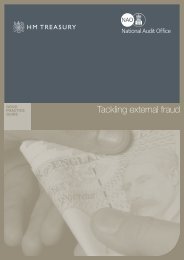4. First case study – the subdivision of the light - HM Treasury
4. First case study – the subdivision of the light - HM Treasury
4. First case study – the subdivision of the light - HM Treasury
Create successful ePaper yourself
Turn your PDF publications into a flip-book with our unique Google optimized e-Paper software.
F05 Ch4 Subdivision <strong>of</strong> <strong>the</strong> <strong>light</strong>.doc<br />
05/04/2006 19:34:00<br />
Technological roulette <strong>–</strong> a multi-disciplinary <strong>study</strong> <strong>of</strong> <strong>the</strong> dynamics <strong>of</strong> innovation in electrical, electronic<br />
and communications engineering.<br />
<strong>4.</strong> <strong>First</strong> <strong>case</strong> <strong>study</strong> <strong>–</strong> <strong>the</strong> <strong>subdivision</strong> <strong>of</strong> <strong>the</strong> <strong>light</strong><br />
operation again.<br />
As a result <strong>of</strong> this success, Edison was appointed as Pope’s assistant and, shortly<br />
afterwards, when Pope left to set up his own company, was promoted and given a salary <strong>of</strong><br />
$300 a month. Clark 1977,p28 In his new position he worked to improve <strong>the</strong> Laws’ indicator<br />
and succeeded in enhancing its performance so that it matched <strong>the</strong> performance <strong>of</strong> that <strong>of</strong> a<br />
rival company, <strong>the</strong> Gold & Stock Telegraph Company.<br />
Shortly after, <strong>the</strong> Laws company was taken over by Western Union, from whose<br />
employ Edison, once again, resigned, this time to set up in business with Pope and J. N.<br />
Ashley, <strong>the</strong> publisher <strong>of</strong> The Telegrapher, as<br />
bespoke electrical engineers and as a general<br />
telegraphic agency. The firm, <strong>of</strong>fered to supply<br />
clients with raw materials or finished apparatus<br />
and even to draw up telegraphic patents on<br />
<strong>the</strong>ir behalf.<br />
Edison designed his Universal Stock<br />
Printer and perfected a new printer, <strong>the</strong> “gold<br />
printer,” which was leased to subscribers for<br />
twenty-five dollars a week. Once again,<br />
Western Union responded to <strong>the</strong> threat <strong>of</strong> competition by buying out its rival. Edison’s<br />
share <strong>of</strong> <strong>the</strong> sale price was $5000 and he used it to set up on his own account.<br />
Marshall Lefferts, a Western Union executive, bid to obtain exclusive rights to his<br />
services. He began to finance Edison’s research, setting specific tasks which left Edison<br />
with little time to work for anyone else. In due course, Lefferts decided to make a firm<br />
contractual arrangement with Edison. He <strong>of</strong>fered $40,000 for <strong>the</strong> patent rights to <strong>the</strong><br />
improvements he had been making to <strong>the</strong> company’s equipment. Edison had thought <strong>the</strong>y<br />
were worth, perhaps, $5,000, but asked Lefferts to name his price. By all reports he was<br />
Clark 1977, p30<br />
astounded at <strong>the</strong> magnitude <strong>of</strong> <strong>the</strong> <strong>of</strong>fer.<br />
The ease with which this money was acquired whetted Edison’s appetite and<br />
prompted him to enter into all manner <strong>of</strong> deals with a variety <strong>of</strong> business partners, and<br />
without any particular regard for <strong>the</strong> contractual niceties <strong>of</strong> <strong>the</strong> arrangements. In <strong>the</strong> spring<br />
<strong>of</strong> 1871, an automatic telegraph system, designed by George D. Little, had been bought by<br />
109<br />
Jehl 1937<br />
Fig. <strong>4.</strong>37 The automatic telegraph (1871)





![AIRTO [Professor Dr Brian Blunden] - HM Treasury](https://img.yumpu.com/15492848/1/184x260/airto-professor-dr-brian-blunden-hm-treasury.jpg?quality=85)










